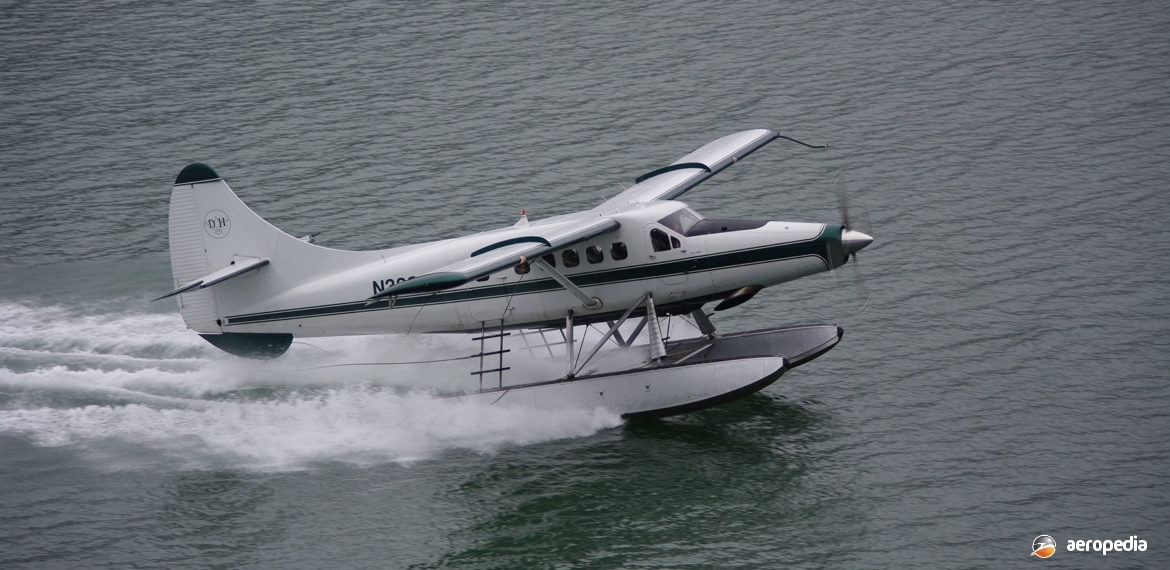Photograph:
Vardax Vazer Dash 3 N338AK (c/n 262) at Juneau, Anchorage in August 2011 (David C Eyre)
Country of origin:
Canada/United States of America
Description:
Commercial utility transport
Power Plant:
One 560 kw (750 shp) Pratt & Whitney Canada PT6A-135 turboprop
Specifications:
- Wingspan: 17.68 m (58 ft)
- Length: 14.02 m (46 ft)
- Height [landplane]: 3.8 m (12 ft 7 in)
- Height [amphibian]: 4.87 m (16 ft)
- Wing area: 34.8 m² (375 sq ft)
- Max cruising speed [landplane] at 3,050 m (10,000 ft): 267 km/h (166 mph)
- Max cruising speed [amphibian]: 241 km/h(150 mph)
- Stalling speed flaps down: 93 km/h (58 mph)
- Max rate of climb at sea level: 365 m/min (1,200 ft/min)
- Service ceiling: 4,875 m (16,000 ft)
- Take-off run [landplane]: 171 m (560 ft)
- Take-off run [amphibian]: 274 m (900 ft)
- Landing run [landplane]: 95 m (310 ft)
- Landing run [amphibian]: 122 m (400 ft)
- Endurance: 5 hrs 18 mins
- Range: 1,203 km (748 miles)
- Usable fuel: 758 kg (1,672 lb)
- Empty weight [amphibian]: 2,223 kg (4,900 lb)
- Useful load [landplane]: 3,810 kg (8,400 lb)
- Useful load [amphibian]: 1,406 kg (3,100 lb)
- Loaded weight [amphibian]: 3,630 kg (8,000 lb)
- Loaded weight [landplane]: 3,770 kg (8,201 lb)
History:
The Vazar Dash 3 was a conversion by the Vardax Corporation of Bellingham, Washington, of the de Havilland DHC-3 Otter to take a turboprop powerplant, the Company in recent years being known as Vazar Aerospace. The conversion of the prototype (N9707B) was completed by Serv-Aero Engineering Inc of Salinas, California and the aircraft received a multiple Supplemental Type Certificate from the American FAA. Re-engined with the Pratt & Whitney PT6A engine, the Otter had much improved performance and a 331 kg (730 lb) increase in its useful load. Engine used was either the PT6A-34 or PT6A-135a driving a three or four-blade Hartzell propeller.
The first conversion by Vardax was completed in 1986 and by January 1990 the Company had received orders for ten conversions. The machine was certificated to operate on wheels, skis, Edo 7170 floats and Edo 7490 amphibious floats. Vardax has completed more than 90 conversions and they are used extensively throughout Canada, Alaska and the United States for tourist flights. Seating was provided for 11 to 16, including the pilot.
With the turboprop the capacious carrying capacity of the Otter gave it a new lease of life. One (N9758N) was obtained by the French Navy for a year-long millennium round-the-world tour but suffered a propeller problem and was lost in a fire. Other manufacturers have carried out conversions to turboprop power, including Harbour Air Seaplanes in Canada, and Kenmore in Washington, USA, which is known for seaplane conversions of the Beaver.
A further conversion of the Otter has been carried out in Canada, this being by Orenda Recip Inc which fitted a 448 kw (600 hp) Orenda OE-600A liquid-cooled V-8 piston engine to a floatplane (C-FEYY). This conversion was carried out after receipt of a contract from Turkish Aerospace Industries to develop a firewall forward powerplant for fire fighting and agricultural work, the Orenda engine being 136 kg (300 lb) lighter than the R-1340 piston engine.
Further conversion companies involved in converting Otters include Viking Air, Recon Air, and Texas Turbines, these companies fitting 671 kw (900 hp) Garrett TPE331-10 or 12JR turboprops. Recon Air describes itself as being the “world’s largest turbine Otter maintainer”, finding and salvaging Otters from all over the world for rebuild and / or turbine conversion. Airtech Canada Aviation has adapted the 746 kw (1,000 hp) PZL ASz-621R-M18 radial engine for the Otter to improve performance.
In Australia a Vazar Dash 3 was imported for operations by Broome Aviation Pty Ltd, of Broome, WA, this machine VH-OTV² (c/n 250 – ex N373A, C-FWYH, IM1731 Indian Air Force) being registered to Vazar Pty Ltd on 13 November 1997 and operating on tourist flights fitted with amphibious floats but was later exported to the United States on 10 December 2008 as N510PR.
A similar aircraft DQ-GLL was operated by Pacific Islands Seaplanes in Fiji. This aircraft (ex N68086, C-GZYR, N3382 and 51-1684 [US Army]) was described as a Hansen turbo conversion. It was seriously damaged in an accident when it turned over on 29 December 2009 off Vomo Island, Fiji. The wreck sat at Nadi airport for some time before it was exported to Canada where it was rebuilt and became C-GHAQ.
A replacement Otter turbine aircraft was obtained, this becoming DQ-PIA (c/n 115 – ex N68056, C-GXYR, N3382, 58-1683 [US Army]) entering service in December 2009 and conveying tourists to Mamanuca island resorts and other centres in the island group. A further example became DQ-SEA (c/n 397v-vex SX-ARU, SX-ARO, XJ-W, 60-397, LN-TSC, C-FQEI, N113DG,HB-TCM, C-FKPU) and operated on amphibious floats in the Fijian islands.
As noted Texas Turbine Conversions has also converted the Otter to turbine power, the aircraft becoming known as the TTC Super Otter and examples are fitted with the Garrett TPE331-10/-12JR turboprop flat rated at 671 kw (900 shp) continuous and 746 kw (1,000 shp) for take-off, this engine having a TBO of 7,000 hours, the aircraft having a standard empty weight of 1,905 kg (4,200 lb) and a gross weight of 3,629 kg (8,000 lb).

